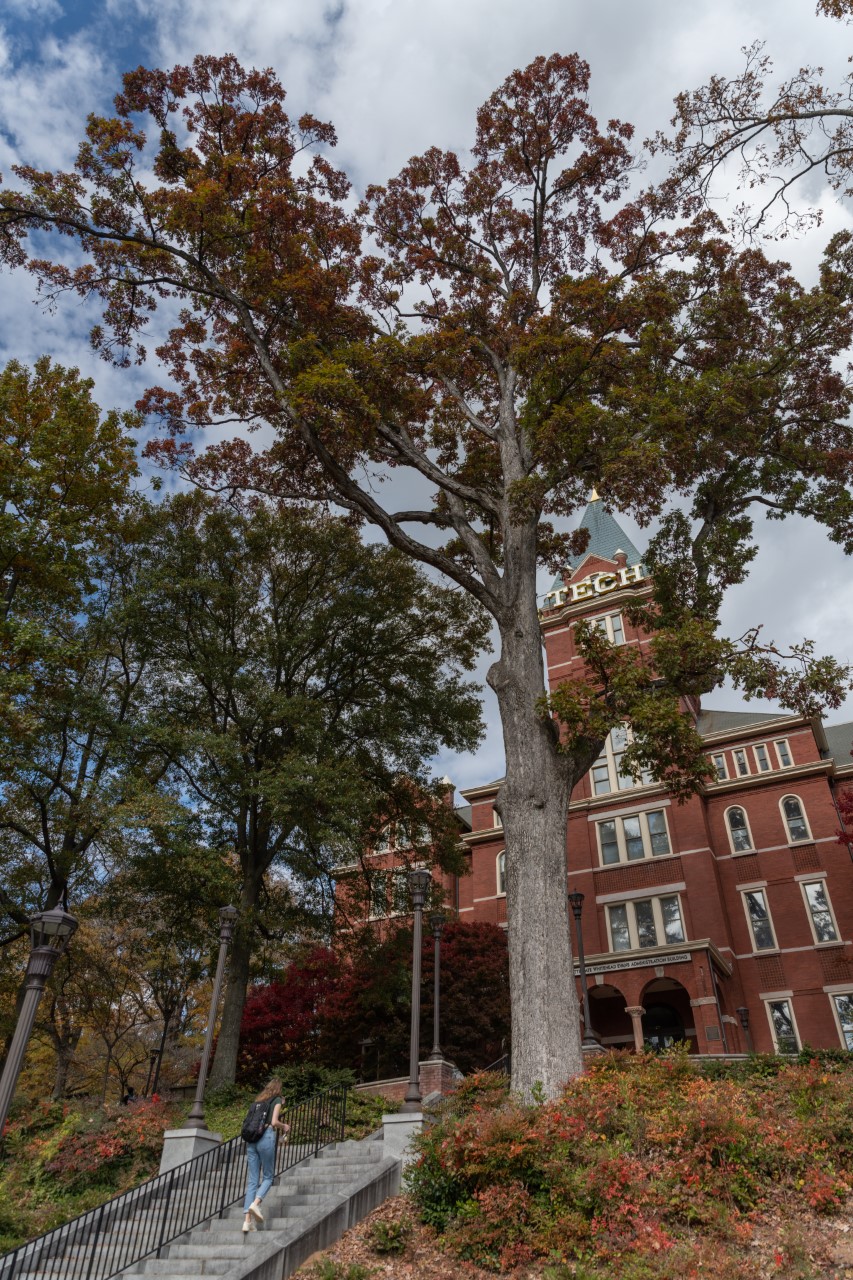
The white oak, or Quercus alba, beside the staircase leading up to Tech Tower proudly frames the tower with its large leafy crown. Standing 103 feet high and almost as iconic as Tech Tower itself, this majestic hardwood has reigned over campus for more than a century. Unfortunately, the oak has been deemed hazardous, which means the tree possesses a significant defect and the potential for falling on a building, car, or pedestrian.
The white oak, or Quercus alba, beside the staircase leading up to Tech Tower proudly frames the tower with its large leafy crown. Standing 103 feet high and almost as iconic as Tech Tower itself, this majestic hardwood has reigned over campus for more than a century.
Unfortunately, the oak has been deemed hazardous, which means the tree possesses a significant defect and the potential for falling on a building, car, or pedestrian. A diverse group of stakeholders work extremely hard to prevent tree failures on campus. Jason Gregory, senior planner and registered landscape architect for Capital Planning and Space Management, and the Landscape Services team have monitored the tree for several years and have done everything possible to help it survive. However, severe root rot is causing it to fail. When a tree of this magnitude is deemed hazardous a second opinion is required.
“Before removing a tree, we have an outside vendor evaluate the tree to make sure that what we say is correct and to make their recommendations as well,” Quentin Holden, campus tree surgeon, said. The outside vendor agreed, and plans are underway for a contractor to remove the oak during winter break.
Once felled, the champion oak will become part of the Campus Tree Cycling Program. Its wood will be evaluated, and the suitable pieces will be sent to a local wood mill to be processed and stored for use in future campus construction projects like The Kendeda Building for Innovative Sustainable Design. In addition, Associate Professor Hugh Crawford from the School of Literature, Media, and Communication, in partnership with Serve-Learn-Sustain, will receive several large pieces of the oak and plans to honor and celebrate the magnificent tree. He will lead a spring semester sophomore course on the cultural history of trees and the Tech Tower white oak. Students will have the opportunity to write an epitaph for the tree.
“Ideally, this seminar will show students how trees have figured in our culture over time,” he said. “By working to memorialize the champion Tech Tower white oak, I hope they will bring that understanding to the broader Tech community.”
Crawford has previous experience in honoring fallen hardwoods on campus. He was the planner behind the memorialization projects of “Big Al,” the willow oak near the Student Center that split in the fall of 2018. (Read more here.)
Crawford also shared that the white oak is the material of choice for weaving baskets in Appalachia and he intends to bring in an artisan to instruct students in that craft. Each student who completes the course will create a handmade basket from fresh, green wood from a white oak. The wood will not come from the Georgia Tech oak, due to the length of time between the removal of the tree and when students will craft the baskets.
Currently, the campus tree count totals more than 14,000. This includes the 600 trees planted in the creation of the EcoCommons and the 300 planted to surround the renovated Campus Center. With the removal of the 100+ year old white oak, 40-60 more trees will be planted on campus as part of the Campus Landscape Master Plan and the Tree Care Replacement Policy. This policy requires that every 1-inch-diameter caliper of tree removed is replaced by a tree of 1-inch caliper or more in diameter. Several species of colorful flowering trees such as dogwoods and redbuds will be planted on the slope where the white oak stands now.
Senior Planner Jason Gregory said, “We’re always sad when we have to remove such a large and majestic tree on campus, but it is part of the management of our urban forest to maintain a safe environment for everyone.”
The removal of the white oak will make for a clearer view of Tech Tower and new trees will take its place with their own opportunity to grow and flourish. With an estimated total campus tree value of more than $11million, Georgia Tech is rich in the beauty and shade of a tree-filled campus. Yet, when the time comes for the removal of one of our oldest and iconic trees, we feel the loss like an old friend. We will miss its abundant leaves framing the tower on the hill.